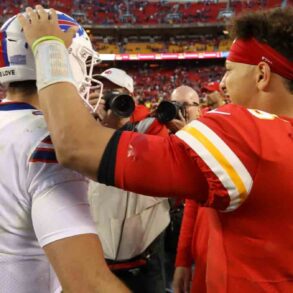The NFL will engage its Competition Committee on technology to take virtual line-to-gain measurements next season, but officials will continue to spot the football.
There’s no current technology being considered that would help determine forward progress, which became a point of contention after Josh Allen was stopped short on a sneak on fourth-and-1 early in the fourth quarter of Buffalo’s 32-29 loss to Kansas City in the AFC championship game.
The league tested Sony’s Hawk-Eye tracking services for virtual line-to-gain measurements in the preseason and in the background during the regular season. The optimal tracking system notifies officiating instantly if a first down was gained after the ball is spotted by hand.
The key word is after. This technology replaces the chain measurement. The NFL has long used two bright orange sticks and a chain — the chain gang — to measure for first downs. That method would remain in a backup capacity.
“What this technology cannot do is take the place of the human element in determining where forward progress ends,” NFL executive Kimberly Fields told The Associated Press on Friday. “There will always be a human official spotting the ball. Once the ball is spotted, then the line-to-gain technology actually does the measurement itself. So I think it’s probably been a point of confusion around what the technology can and can’t do. There will always be a human element because of the forward progress conversation.”
Fields said an average of 12 measurements took place each week during the regular season. The new technology would’ve dropped the time spent to measure from 75 seconds to 35 seconds.
NFL balls have been equipped with Zebra microchips since 2017, powering the NFL’s Next Gen Stats data product. The chips are also affixed to players’ pads. They provide various data and metrics that help clubs, media and fans with player evaluation and analysis of team performance. But these chips can’t determine where a player was tackled, whether a player is down by contact or which team gained possession of a loose ball to the precision necessary for officiating use.
The league also began using boundary line cameras in Week 5 to assist with replay reviews. The cameras were installed in each of the 30 stadiums along the end line, goal line and sideline. Usage was limited to scores, plays with under two minutes remaining and turnovers.
Discussion for expanding its use to coaches’ challenges and replay assist is ongoing and would have to be approved by the Competition Committee.
Fields said the league also experimented with providing back judges smart watches to assist with objective information so they can make decisions faster, specifically as it relates to the play clock.
“We want to make the game efficient and more accurate,” Fields said. “The things that we do around technology, if it’s not going to make the process better, if it’s not going to assist our officials, then we shouldn’t be doing it. Everything that we do is going through a rigorous testing process to make sure we are making things easier and more efficient.”
___
AP NFL: https://apnews.com/hub/nfl
This post was originally published on this site be sure to check out more of their content.




